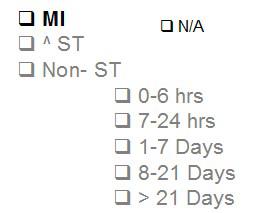Myocardial Ischemia: The Best Timing for Engaging CPB for Revascularization

Editors Note:
Having been in the field for awhile, and being an STS data coordinator, the timing of surgery for patients suffering from an acute evolving myocardial infarction (AEMI) has always intrigued me.
The STS data form is very specific in tracking these intervals, and I am naturally curious as to what the impact on morbidity/mortality is when taking into account of the timing of the procedure; in other words, operating immediately versus the next day, two days or a week later.
STS Harvest Requirements
=
After reading many articles, it seems that the jury is still out on this one. The following conclusion seems to summarize current consensus of timing and intervention requiring the use of CPB:
“Patients with acute MI appear to differ little from patients with more stable coronary disease. Age, co-morbidities, and ventricular function appear to be more important considerations than delays between infarction and coronary bypass. Earlier surgery does not appear to confer additional risk if patients can be adequately stabilized preoperatively and may reduce the risk of additional ischemic injury during a pro-longed waiting period.”
Myocardial Ischemia
Prevention and treatment of perioperative myocardial ischemia is a primary consideration. Two consistent factors associated with the pathogenesis of myocardial ischemia are inadequate oxygen supply to the myocardium due to localized coronary lesions, and excessive oxygen demand due to increased hemodynamic workload associated with increased heart rate, blood pressure, or adrenergic stimulation of myocardial contractility. Myocardial ischemia can be detected by observing changes in the ECG, identifying wall motion abnormalities using TEE, or manifested as increased pulmonary artery wedge pressures.
Ischemic changes in leads II, III, and aVF may reflect involvement of the right atrium, right ventricle, sinoatrial node, and atrioventricular node due to decreased perfusion from right coronary artery. Leads V3-V5 target the anterolateral aspect of the left ventricle and reflect hypoperfusion through the left anterior descending artery. Leads I and aVL identify ischemia to the lateral wall of the left ventricle supplied by the circumflex artery.
Treatment for ischemia may include several therapeutic steps such reducing wall tension with nitroglycerin, controlling heart rate with ß-adrenergic blocking agents, reducing contractility by controlling myocardial depression with increased anesthetic levels, and maintaining coronary perfusion pressure using a non-chronotropic agent such as phenylephrine.
Current guidelines
The most recent guidelines published by the American College of Cardiology state that in patients who have had an ST-segment elevation MI (STEMI), CABG mortality is elevated for the first three to seven days after infarction, and the benefit of revascularization must be balanced against this increased risk. They have given a class IIb recommendation that stable patients who have had an STEMI and who have incurred a significant fall in LV function should have their surgery delayed to allow myocardial recovery to occur. Interestingly, they have not specified the length of time that such a delay should occur. They also state that the committee believes that if stable STEMI patients with preserved LV function require surgical revascularization, CABG can be undertaken within several days of the infarction without an increased risk. The choice of wording and the lack of specific recommendations highlight the ambiguity of the issue.
Click Image to view source article
Myocardial ischemia after cardiopulmonary bypass.
Intraoperatively, myocardial ischemia is more common after cardiopulmonary bypass (CPB) than before CPB. Ischemia associated with coronary vasospasm and thrombosis may be much more common toward the end of surgery and early in the postoperative period than previously appreciated. This may be because the coagulation system is altered during CPB, and the coronary endothelium is damaged significantly as a result of cardioplegic arrest followed by reperfusion. In this milieu, vasospasm and thrombosis may be caused by the administration of protamine. Some of the ischemia observed in this period actually is not reversible and is associated with myocardial injury and infarction. It may be ameliorated by the administration of calcium channel blockers, aspirin, and anticoagulants. Electrocardiography may be the most suitable modality for the detection of ischemia after CPB and postoperatively. During this period, many episodes of ST deviation are of a nonischemic etiology, and the ECG needs careful interpretation. Transesophageal echocardiography is suitable for use intraoperatively and early on in the intensive care unit.
References
- Mastropietro C. Anesthesia for cardiac and peripheral vascular surgery. In Waugaman WR, Foster SD, Rigor, BM eds. Principles and Practice of Nurse Anesthesia. Norwalk, Appleton & Lange; 1992:705-748.
- Flacke JW, Flacke WE. Clonidine prevention of myocardial ischemia during cardiac surgery: Will this change outcome? Journal of Cardiothoracic and Vascular Anesthesia. 1993;7:383-385.
- Swartz AJ, Maddi R. Anethesia for cardiac surgery. In Liu PL ed. Principles and Procedures in Anesthesiology. Philadelphia PA: J.B. Lippincott;1992:339-349.




